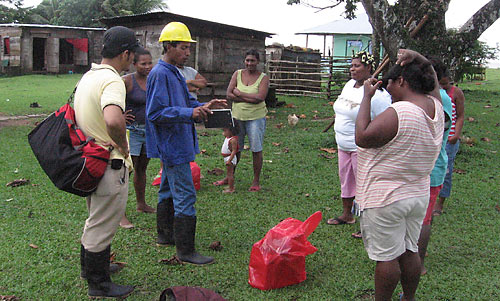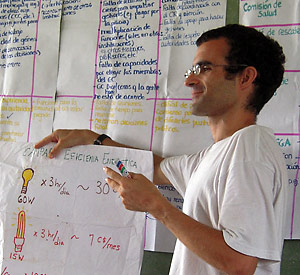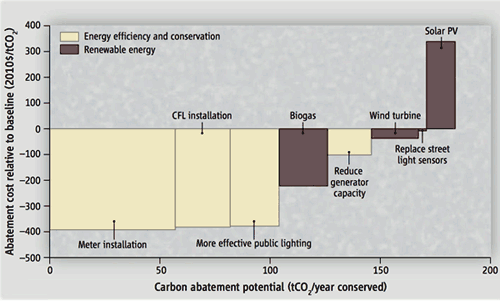Investments in rural energy efficiency, renewable energy reduce poverty, greenhouse gas emissions
A clean-energy initiative in rural Nicaragua shows that developing nations can take cost-effective steps to reduce carbon emissions while helping the rural poor to reduce their energy expenses, according to researchers at UC Berkeley.
November 25, 2010
In the developing world, reducing greenhouse gas emissions is often seen as being in conflict with alleviating poverty, since improving the standard of living is usually associated with increased energy use.

Employees of the NGO blueEnergy and the Nicaraguan electricity company ENEL discuss energy efficiency and replace light bulbs in Marshall Point (Christian Casillas photo)
A clean energy development initiative in rural Nicaragua, however, demonstrates that there are cost effective steps developing nations can take to reduce carbon emissions and at the same time help the rural poor reduce their energy expenses, according to researchers from the University of California, Berkeley.
In a report in this week’s issue of the journal Science, UC Berkeley graduate student Christian E. Casillas and professor Daniel M. Kammen analyze simple steps taken by Nicaragua’s Ministry of Energy & Mines and the nonprofit blueEnergy to reduce the cost of energy while reducing carbon emissions for a community of 172 households on the country’s Mosquito Coast.
The villages of Orinoco and Marshall Point are off the nation’s electric grid and obtain their power from diesel generators, according to Casillas. Until last year, however, the homes had no electricity meters; homeowners were billed according to the appliances they owned. This, Casillas said, encouraged indiscriminate energy use, with lights, televisions and radios remaining on, even when not being used.
After the government installed meters, however, energy use dropped by 28 percent, and many people’s electric bills also dropped.
The non-governmental organization blueEnergy, whose administrative office is in San Francisco, subsequently worked with the government to institute in Orinoco and Marshall Point a simple energy conservation campaign: Villagers were offered two efficient compact fluorescent light bulbs (CFL) in exchange for two incandescent bulbs. This program reduced household energy use by an additional 17 percent, on average.
The net result was less diesel burned, even allowing for the fact that the community’s reduced energy needs allowed the local energy supplier to run its generators two extra hours each day, providing longer service to customers. In the month after the conservation campaign, electricity bills dropped in 37 percent of the households in Orinoco.

Christian Casillas explains the energy savings from compact fluorescent light bulbs during a participatory workshop for Orinoco residents. (Maite Niels photo)
“What we are saying is, if you’re thinking about some of the lowest hanging fruit to lower greenhouse gas emissions, rural communities should be one of the first places you look for making small but very cheap carbon reductions,” said Casillas, who is an advisor to blueEnergy.
Microgrids like the one in Nicaragua, often powered by diesel generators, are found by the thousands around the world, particularly in India and China, Casillas added.
“They’re dirty, have high emissions, high energy costs and questionable reliability, so targeting these microgrids has the potential for improving access to energy services for those communities while at the same time, for the dollars invested, getting greater reductions in carbon emissions than you might get investing in similar measures where the cost of energy is cheaper, such as in the cities,” he said.
“We hope that this paper will spur a wave of efforts to build similar community level carbon abatement and energy service tools, so that communities often ignored or lumped together as ‘those billions without modern energy’ can create their own locally appropriate development goals, and groups working with them can develop energy solutions, not just efforts to disperse hardware,” said Kammen, a Distinguished Professor of Energy at UC Berkeley who is currently serving as the chief technical specialist for renewable energy and energy efficiency for the World Bank. Kammen also is director of UC Berkeley’s Renewable and Appropriate Energy Laboratory and a professor in both the Energy and Resources Group and the Goldman School of Public Policy.
The researchers used an economic tool called a marginal abatement cost (MAC) curve to analyze energy use in the community and to pinpoint the areas where investments would save the most energy and the most money. The tool, popularized by the global management consulting firm McKinsey & Company, has typically been used on a global or country-wide scale to target areas for carbon abatement, but not for assessing small communities, Casillas said.

A marginal abatement cost (MAC) curve for the communities of Orinoco and Marshall Point in Nicaragua shows which investments will reduce costs and save energy (those below the line) and which will lower greenhouse gas emissions, but at a cost (above the line). Such curves tell planners where to get the most bang for the buck in terms of carbon reduction. (Credit: Daniel Kammen, Christian Casillas/UC Berkeley)
The cheapest investments for the impact turned out to be the ones taken by the government and blueEnergy, though the model predicts further energy and carbon savings from other simple measures, such as more effective public lighting and use of biogas and wind turbines.
“The advantage of this cost curve for local governments that may have as their mandate better energy services is that it can tell them what the cheapest investments are and how much emissions reductions they’ll be able to get for their investments,” Casillas said. “This allows them to see, with the limited funds available, how to get the most bang for the buck.”
“This paper presents a theoretical and analytic framework that opens a vital new door to value the time, energy and opportunities for the rural poor and those on the outskirts of urban areas. It also recognizes the carbon and financial benefits of integrated strategies that combine energy efficiency with renewable energy to meet energy access, climate protection and economic development goals,” Kammen said.
This work was supported by the Energy Foundation, the Karsten Family Foundation, and UC Berkeley’s Class of 1935.